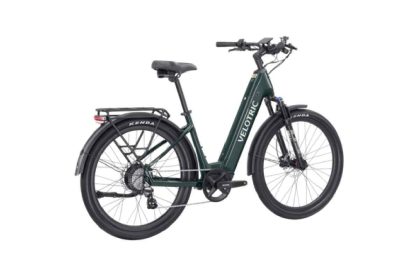Table of Contents
Introduction
Manufacturing Technology is the process of transforming raw materials into valuable goods by using various resources such as man, machine, time, and capital.
Over time, the machines used for manufacturing processes have undergone various developments and revolutionized the manufacturing process.
These modern techniques and technologies have not only reduced the workload on humans but also improved the output quality.
This article discusses how manufacturing technology is constantly changing and what practical effects it has on the industry.
Traditional Manufacturing Techniques
The manufacturing industry is one of the oldest known industries that produces valuable products to ease the lives of humans.
Traditional manufacturing techniques consist of manual operation of tools to produce the desired product.
These techniques include manufacturing processes such as casting, forging, cutting, etc.
However, manual processes are prone to human limitations such as fatigue, distractions, and other human errors, thereby reducing their efficiency for large-scale production.
With the advancement in technology, all the manual manufacturing operations are being replaced by computer-controlled automated systems, known as CNC.
Modern CNC Technology- The Present
Computer numerical control (CNC) technology has revolutionized the manufacturing industry by reducing human interaction with the process.
CNC technology consists of a computer system that controls various movements of the cutting tool to perform the desired cut.
It provides various advantages over traditional manufacturing, such as higher accuracy, better repeatability, safer operation, quick cycle time, etc.
CNC technology has upgraded various traditional manufacturing tools in the form of CNC routers, CNC mills, CNC plasma cutters, etc.
Apart from these, there are various advanced, non-conventional manufacturing tools such as CNC laser cutters, CNC waterjet machines, electrical discharge machining (EDM), etc.
One significant advancement in this field is the incorporation of CNC technology in die-cutting applications, which has transformed the precision and efficiency of creating intricate designs. This integration allows for more complex and detailed patterns to be produced, far surpassing the capabilities of manual die-cutting methods.
CNC Routers and Mills
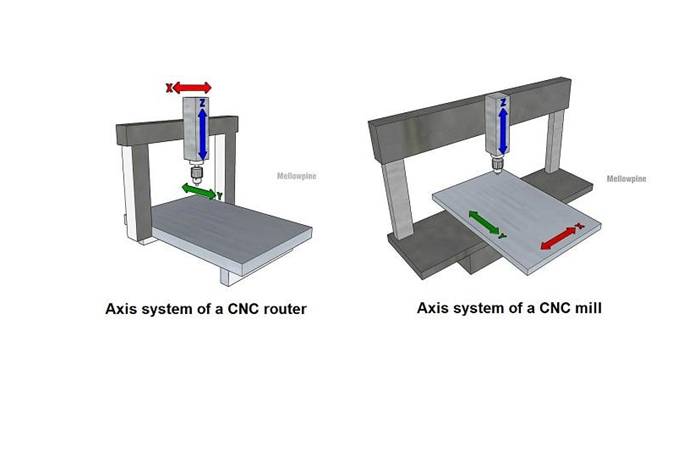
A CNC router consist of a high-speed rotating tool that moves along the X, Y, and Z axes to perform the desired cutting operation.
These machines are ideal for machining large workpieces, such as woodworking.
On the other hand, CNC mills consist of a high-speed rotating tool that can move along the Z-axis, while the workbed moves along the X and Y axes.
The combined movement of the cutting tool and the workbed results in the desired manufacturing operation.
CNC mills provide a comparatively smaller work area with greater rigidity, ideal for machining metal workpieces.
CNC Lathe
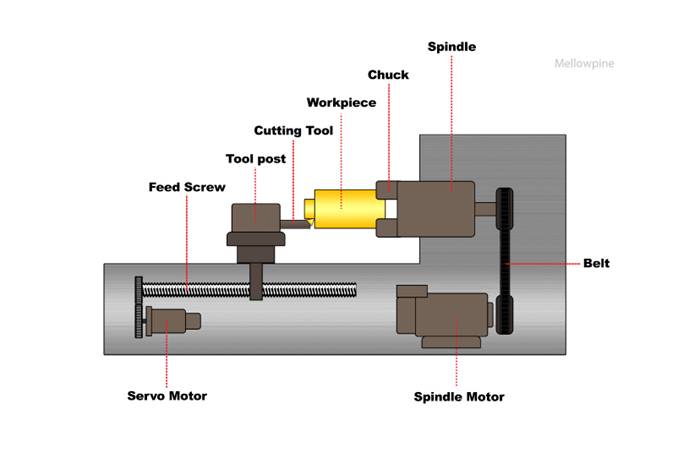
Parts of a lathe
CNC lathe works similar to a traditional lathe, with the only difference being the integration of computer control for improved accuracy.
These machines are used for performing axisymmetric machining operations, such as turning, facing, threading, boring, drilling, knurling, etc.
CNC lathe consists of a high-speed rotating workpiece and a computer-controlled cutting tool that moves along the X and Z axes to produce the desired cut.
Some of the popular applications of lathe machines can be found in woodworking, automobile, and aerospace industries.
Laser Cutters
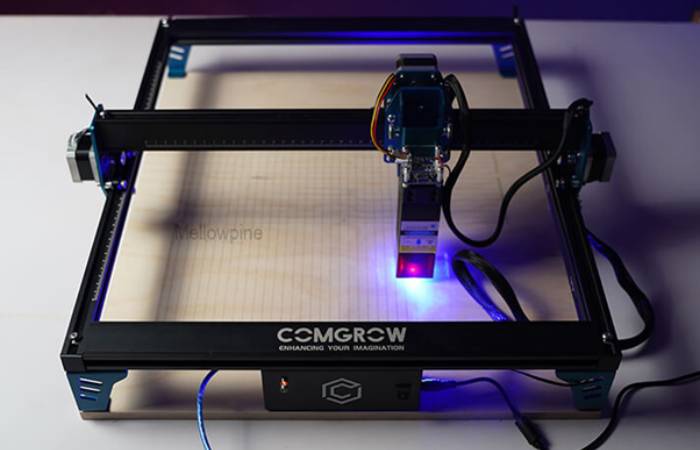
Comgrow Z1 laser cutter
Laser cutters use a high-energy laser beam to melt and vaporize the material, thereby performing the cut.
The computer system controls the movement of the laser head and precisely traces the desired pattern to produce the required cut.
Furthermore, its non-contact nature and tight spot size make it ideal for performing intricate cuts even in the most delicate material.
There are generally three types of lasers that are used in laser cutters: fiber lasers, CO2 lasers, and diode lasers.
Fiber laser is a relatively new technology that is used for cutting and engraving metal workpieces.
Whereas CO2 lasers are ideal for cutting metals and non-metals, but cannot be used for engraving metal workpieces.
On the other hand, diode lasers are low-powered lasers that can be used for engraving almost all types of materials, but do not perform well on thick materials.
However, the advancement in technology has introduced highly powerful diode laser cutters that combine the output of multiple diode lasers to produce a powerful laser beam.
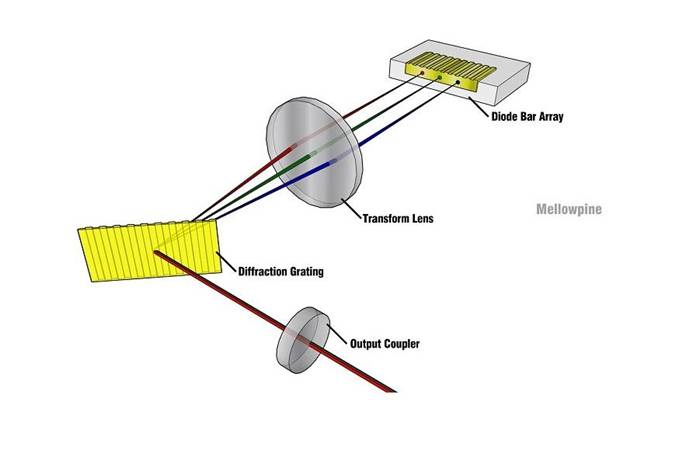
Combining the power of multiple diodes to produce a powerful diode laser beam
These powerful diode laser cutters are relatively new and are not readily found on the market.
CNC Waterjet cutter and EDM
CNC waterjet cutting and EDM are advanced machining technologies that are used for applications where extremely precise cuts are required.
Waterjet cutter uses a high-pressure jet of water, accompanied by fine abrasive material, to erode the workpiece material and perform the desired cut.
It is a versatile machining operation that can be used on all types of materials, like paper, stone, metal, plastic, wood, granite, glass, etc.
On the other hand, EDM uses electric discharge to perform precision cuts in workpiece.
This process is also known as “spark erosion,” as the spark produced between the electrode and the workpiece increases the temperature high enough to vaporize the material.
Due to its electric nature, EDM can only be used for machining of electrically conductive materials, like metals.
Although both these techniques provide high accuracy and precision, they are significantly slower than laser cutting.
Therefore, waterjet cutting and EDM are ideal for applications where high precision is of key importance, irrespective of the cycle time.
3D Printers
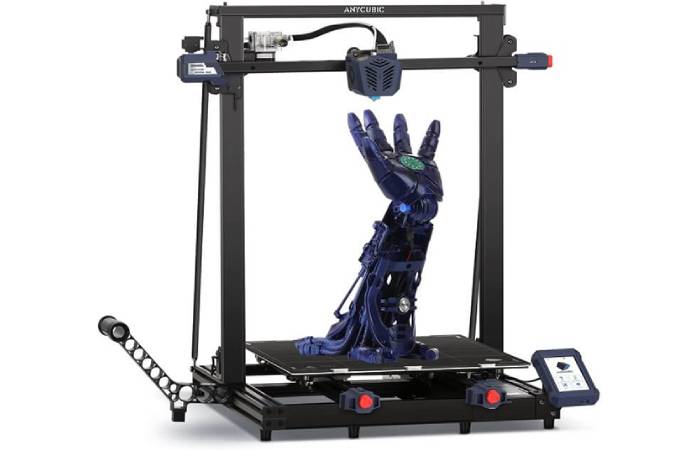
3D printer
Unlike other CNC machining processes that follow a subtractive approach, 3D printing is an additive manufacturing process.
In this process, the desired part is produced by adding layers of material in the desired shape.
A computer system controls the movement of the nozzle, thereby ensuring high accuracy with tight tolerances.
These machines are generally found in small, desktop sizes, suitable for printing plastic workpieces.
However, with the constant development of manufacturing technology, these machines are now available in large, industrial sizes, capable of printing various materials like plastics, metals, organic tissues, concrete, etc.
These large size 3D printers are even capable of printing a rigid concrete structure and can be used for printing a complete house in a few days’ time.
All these advancements in technology have revolutionized the manufacturing process and enabled us to produce parts with extremely high accuracy and a smooth surface finish with a quick cycle time.
Advanced Robotic Technology- The Future
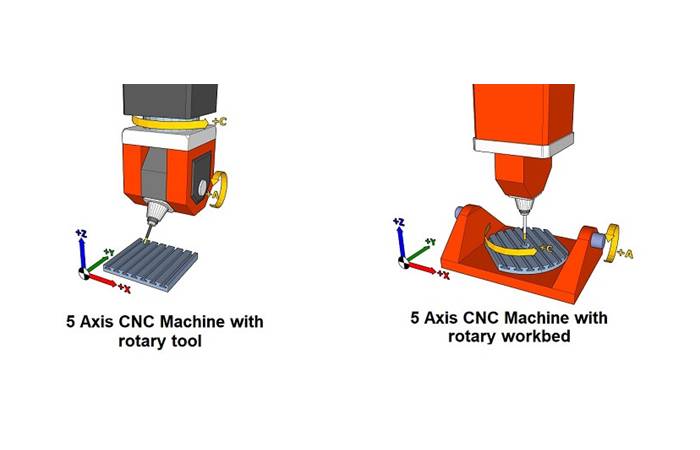
CNC machines have automated the manufacturing process. However, it still requires human input in the form of changing the cutting tool, loading, unloading, and transferring the workpiece from one machine to another.
Advanced CNC machines consist of higher axis systems, making them suitable for producing extremely complex parts with high accuracy and quick cycle time.
Unlike traditional CNC machines, which consist of 2 or 3-axis systems, these CNC machines can consist of 4, 5, or even 6-axis systems.
However, as the number of axes increases, the complexity of the machining process also increases, and requires a specialist programmer to program the machine.
A 6-axis CNC machine is a versatile machine that can perform almost every machining operation on a single machine.
With the addition of robotic arms, it can also automate processes such as tool changing, loading, and unloading of the workpiece.
These machines are not yet readily found in the manufacturing industry, except for some highly sophisticated industries such as aerospace and medical industries.
But with the ever-increasing quality standards and need for complex geometries, these machines might be found in almost every industrial application in the near future.
Final Thoughts
Manufacturing technology is undergoing constant development to enhance the quality of products being produced.
These advancements not only improve the quality of products but also transform manual labor into technical work, thereby improving work safety.
While many fear that the popularity of CNC workshops will result in the unemployment of humans, the advancement in technology improves the standard of living and provides opportunities for roles such as CNC operator, CNC machinist, CNC programmer, etc.
Frequently Asked Questions (FAQ)
Can modern manufacturing technologies be applied to woodworking?
Yes, modern manufacturing technologies are equally applicable to woodworking as they are to metalworking. CNC routers are one of the most popularly used tools for woodworking projects such as sign making, furniture making, etc.
What kinds of operations can a multi-axis lathe perform?
A multi-axis lathe (with a 5 or 6-axis system) is a powerful tool that can be used for various applications like turning, knurling, drilling, milling, facing, sanding, etc. These machines consist of a rotating tool as well as a rotating workpiece, making it possible to access the workpiece from all sides and perform complex machining operations with relative ease.
What kind of materials can be engraved by using a laser cutter?
Laser cutters provide the ability to control laser power and dwell time of the laser, thereby making it possible to perform engraving operations on almost any material. Diode lasers are best suited for engraving operations. However, laser cutters cannot be used for processing materials that contain vinyl content, such as PVC, as they produce harmful fumes that can harm the operator and damage the machine.
Related posts
Recent Posts
The Best 10 Electronics near Florence, AZ
The Best 10 Electronics near Florence, AZ – Did you buy a new house in Florence, Arizona, and search for…
The Velotric Discover Experience: Testimonials from Happy Riders
In the burgeoning world of e-bikes, one name that consistently garners attention is Velotric. Known for its innovative design and…

![How Manufacturing Technology is Changing? [2024]](https://www.computertechreviews.com/wp-content/uploads/2022/07/Manufacturing-Technology-1200x675.webp)

